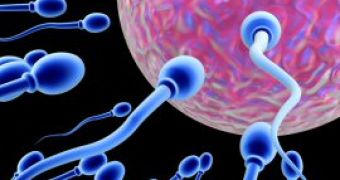This is a breakthrough in explaining egg fecundation and a research that could help us fight against many deadly bugs. A team made of researchers from UT Southwestern Medical Center and Imperial College London has described the basic gene mechanism of reproduction, in a research published online in the journal "Genes and Development."
Besides explaining why most species cannot interbreed, the study could have a first "victim": malaria, a disease that makes over 1 million casualties along the tropics, annually.
The sexual reproduction starts with two proteins: one binds the sperm to the egg, the other fuses their membranes in order to result a sole cell. The same process was found to apply to "male" and "female" malaria cells. By blocking the second protein, the spread of the disease could be stopped, no anti-malaria vaccine existing at the time.
The discovery began with the single-celled green alga Chlamydomonas, common in soil and water and easy to keep in the laboratory. The microorganism research could bring an "altruistic vaccine."
"Although the study involved only single-celled organisms, the use of two different proteins in the two-step fertilization process may be the case in all species," said senior author Dr. William Snell, professor of cell biology at UT Southwestern.
The protein (read gene) of egg and sperm binding may be unique to each species in most cases, but the fusion protein may be universal. The HAP2, the fusion protein (gene) of Chlamydomonas, was also found in superior plants, some being important crops like corn and wheat.
"For the parasite that causes malaria, fusion is controlled by a gene not found in mammals, so blocking this step might prove effective in stanching the spread of the disease without harming humans," said Snell.
Chlamydomonas can breed sexually, not via egg and sperm, but with cells that are "males" and "females." The same system is used by Plasmodium, the protozoa that cause malaria. When HAP2 was blocked in Plasmodium cells, reproduction was halted. Plasmodium devoid of HAP2 and injected into mice could cause malaria in the animals, but the mosquitoes sucking this mouse blood did not get infected with Plasmodium and could not transmit the parasite to other animals. Plasmodia breed inside the mosquito's gut as a crucial step in the life cycle.
Why no inter-breeding
Rarely, closely related species can interbreed, like horses and donkeys producing mules, or lions and tigers producing ligers. Anyway, these hybrids are sterile.
"If the first step in reproduction, binding of egg and sperm, is controlled by a single gene per species, then the binding step would serve as a gatekeeper to prevent incompatible cells from getting close. Evolutionarily, this scheme makes sense, because it would take only a mutation in the single gene that controls egg-sperm binding to create a new species. There has been a lot of speculation about species-specific egg-sperm binding and fusion and whether the two steps involve the same or different proteins, but no one had the molecules to show this," said Snell.

 14 DAY TRIAL //
14 DAY TRIAL //